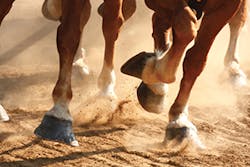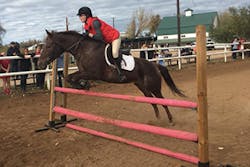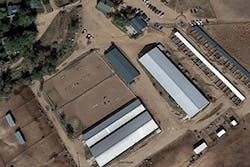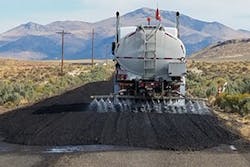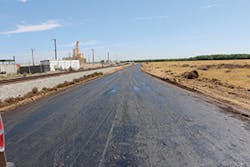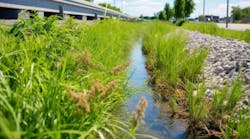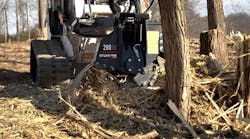EPA has a commonly accepted statement on dust: “One car making one pass on one mile of dirt or gravel road one time each day for one year creates one ton of dust.” It doesn’t have a comparable statement regarding horses, but a similar calculation might be possible.
Tara Gandomcar-Hieb is the owner and manager of Cottonwood Riding Club, home of the Denver Polo Club. The club is a 100-acre equestrian facility that caters to riding disciplines including English and Western and from children’s instruction to horse shows.
The club has four outdoor arenas, including one which is lighted for night riding, along with a well-lit 270-foot by 80-foot indoor arena. The club also includes four regulation lunging pens, a cross-country course, a pro shop, and a clubhouse that sits adjacent to Chatfield State Park just south of Denver. The riding club took its name from the 100-year old cottonwood trees that line the scenic riding trails.
In all, says Gandomcar-Hieb, there may be up to 40 horses riding in the club’s arenas over the course of a day. One outdoor arena at Cottonwood is 30,000 square feet with 2 to 3 inches of footing and soil. With horses coming through eight to ten at a time, there tends to be a lot of dust kicked up.
“We have a sand footing,” she says. “The horse hooves pulverize the sand, and it becomes airborne. After so many horses, it just turns into fine dust.”
There are a variety of benefits of having a good dust control program, including prolonging the life of the footing and having less particulate matter in the air. Other benefits include less equipment maintenance and fewer respiratory problems for riders and horses alike.
A Pennsylvania State University study found that dust poses another kind of safety hazard: It decreases visibility for motorists. A similar problem exists in the arenas. “Dust isn’t good for health,” she says, “but on a smaller scale, the instructors can’t see the riders. So there could be a safety problem there.”
She continues, “We wanted something that would control dust well but would be sensitive to our horses and the riders, too. We wanted no adverse effects on the horse hooves. We were using magnesium chloride, but it only lasted about a month. And our footing deteriorated after a while. It was so fluffy—like fine powder.”
The Cottonwood Riding Club
Steve Staples, owner of Nox Blending Co. in Littleton, CO, and distributor for Global Environmental Solutions, contacted Tara about GES products. He presented a product that was specifically formulated for dust control in horse arenas—ArenaKleen.
ArenaKleen is manufactured by Global Environmental Solutions, originally Dirt Glue Enterprises. GES, makers of high-tech soil stabilization products for both water and wind erosion control, has corporate headquarters in Salem, NH, and warehouse locations throughout the US.
ArenaKleen works without water, so it never dries out or evaporates and doesn’t wash away with rain. It eliminates dust in all types of arena footings, including sand, sand dust, finely screened gravel, and blends of rubber, wood, leather, and other footing blends.
“We did the two outdoor arenas first, around July 17. Then the last week of July we did the indoor arena. Each arena took upward of 900 gallons,” says Staples. “And they haven’t had to water since we put it down.”
Application rates, he says, are figured on a “per inch” rate according to the soil depth. “We treat in the range of 600 gallons per acre, and that would be doubled for a two-inch soil depth. So, for $5,000, that gives them 12 to 18 months, about a year, of dust control. Eighteen months for sure, on the indoor arena.”
ArenaKleen and DustLess (another GES product) are intended for treating the deeper soils, says Staples. “They seek out the dry material—the dust—quickly. With that sand dust, consider that a construction worker who’s working in it all day is required to wear a dust mask. So we need to think about our kids riding in it.”
In terms of dust control options, the most commonly used in arenas include water and chlorides. Water acts by “floating” the soil particles, separating them from each other. Water fills the void once the soil reaches the optimum moisture content. The problem is that once it passes that optimum moisture level, it just becomes mud.
Chlorides work by drawing moisture from the air. Sodium chloride, also used as de-icing salt, absorbs water at 76% relative humidity, reduces the rate of water evaporation by a factor of 1.3, and lowers the freezing point of water. Calcium and magnesium chlorides are effective dust suppressants. However, calcium chloride absorbs moisture at 29% relative humidity—just when dust control is needed the most. Magnesium chloride is similar, but absorbs water at 32% relative humidity and reduces water evaporation by 3.1 times. When chlorides dry out, they create their own dust as well, notes Chris Rider, chief technical officer with GES.
ArenaKleen works differently from water or chlorides. It’s formulated to absorb “into” soil and dust particles rather than surrounding the dust particles as water does. This direct contact of the soil particles, one to another, creates more stability in the soil or arena footing material. It increases density and keeps the surface firm. This offers better traction, fewer shears, and no stickiness or tracking. It’s neither acidic or alkaline, and unlike chlorides it’s non-corrosive. It’s not hazardous and doesn’t require water. This also allows sprinklers or rainwater to fall on it without diluting it or washing it away.
As horses work or perform, they use up to 3,000% more air than when resting. Idaho veterinarian Melinda Roche of Roche Equine, an exclusively equine clinic, explains that the problem is worse in the colder winter months because there’s less ventilation in the arenas. The dust has to be suppressed somehow, or watered. “If the horses are breathing in the dust, it causes respiratory problems specific to horses. It’s called inflammatory airway disease, or IAD. And it’s very costly for vets to treat. Plus, it limits their ability to perform, no matter what they’re doing.”
Gandomcar-Hieb was impressed with Nox Blending and the dust suppressant applications. “I had no prep work to do at all,” she says. “The ArenaKleen application was sprayed right on the footing, and will last for 12 to 18 months. It was applied early summer, and it looks the same as when we first put down the original footing.”
Staples offers some advice on the challenges of dust control in horse arenas. “A lot of what’s added into the footing materials, like sawdust, sand, wood chips, rubber, and old carpet fibers, makes it break down faster. It will need more maintenance and upkeep because all that stuff floats in the air. And there’s dust that drifts in from other places. So the more of that stuff that’s in the footings, the more maintenance they’ll have.”
Bald Mountain Mine
When Marc Fonger says he gives the guys a ride to work, it’s a total understatement. Fonger, superintendent of roads for KG Mining (Bald Mountain) Inc., says the company has four buses that meet in Elko, NV, to shuttle workers to and from the mine. Altogether, about 550 people a day work in 12 1/2 hour shifts, he says. And on top of that, the company runs about 40 trucks on the roads each day as well. All of this vehicle movement creates a lot of dust for him to try to get under control.
“There’s 50 miles of dirt access roads at the mine,” says Fonger. “There are trucks to haul crews to and from the mine, fuel delivery trucks, and also some light vehicles.”
These “heap leach” gold mines are water dependent, so any measures operators can find to keep the dust down and off the roads—and vehicles—without using a lot of water are a bonus, in Fonger’s book.
Dan Nordyke, sales manager for EnviroTech Services in Nevada, says the company previously used magnesium chloride before switching to Durablend at the open-pit Humboldt County mine.
“The road is first graded for preparation and watered,” explains Nordyke. “They come by and spray Durablend at .35 gallons per square yard. Just one shot and they’re okay for the summer—no maintenance or anything.”
After treatment with Earthbind
The Kinross Gold Corporation, parent company of KG Mining (Bald Mountain), acquired its newest mine in 2016. The mine itself has been in operation since the 1980s. “There’s a leach pad, an earthen pad lined with plastic,” says Fonger. “They leach the ore with cyanide. The gold ore stays at the mine. But the gold, after it’s leached out, is made into the gold bars and sold on the open market.”
Cyanide may sound scary for the environment in the northern Nevada desert, but Kinross is diligent about its environmental responsibilities. It has been awarded the US Bureau of Land Management (BLM) National Hardrock Mineral Environmental Award three times since 2003 for its reclamation work. Kinross has operations in Fort Knox, KY; Kupol-Dvoinoye, Russia; Round and Bald Mountains in Nevada; and northwestern Mauritania. KG Mining (Bald Mountain) is conscientious about its water efficiency and operational costs at the Elko site.
“Using the computerized truck system, over about a mile a crew can deliver 4,500 gallons of product. That’s one load,” says Nordyke. “Water brings Durablend into the soil that’s been graded. Previously, the road was bug dust, just like finely milled powder. The Durablend packed the fines down so well that the trucks were driving like they were on a regular highway. They had to put up road signs saying 50 miles per hour. One truck was clocked at 70 miles per hour since the road was packed using the Durablend.”
EnviroTech Services Inc., a Greeley, CO-based manufacturer and national distributor of dust control and de-icing products, developed the Durablend line of products to offer a variety of options for dust control on roads where regular chlorides are an undesirable choice due to environmental concerns. By using Durablend on the access roads, the mine was able to achieve the same performance as with previous treatments with chloride products, but with additional savings on product. Using a compaction aid offered greater water resistance on the road surface, better erosion control, and better trapping of fines to the road surface.
Nordyke notes that rolling the surface after grading helps push the product and water into the top half-inch of the road, where compaction is important. Continued driving on the road actually reduces the loss of any road base.
The Nevada Department of Conservation and Natural Resources teamed up with KG Mining (Bald Mountain) in 2017 to set aside 10,000 acres for sage grouse habitat conservation. The mine will accumulate conservation credits with the state of Nevada for its participation in the agreement. Kinross will implement BMPs for grazing, maintain fences, and preserve the sage grouse habitat for 30 years.
“In the spirit of responsible mining, we have committed to a variety of voluntary environmental protection and mitigation measures,” says Randy Burggraff, vice president and general manager at Bald Mountain. “So there is a net conservation gain to the sage grouse.”
The use of Durablend on the roads close by also helped the Bald Mountain mine achieve the Nevada Excellence in Mine Reclamation Community Award after the Nevada Department of Wildlife nominated the site in two categories. KG Mining (Bald Mountain) was praised for setting aside some 1,100 acres for mule deer migration. This allows safe movement for the deer during ongoing 24-hour mining operations.
Mixing it Up to Stop Dust
Koenig’s Custom Application provides dust suppression for vineyards, forestry operations, and agricultural side roads in Oregon. Robin Koenig has used Earthbind products in various climates for the past 17 years. In western Oregon, the Willamette Valley might see from 36 to 80 inches of rain annually, depending on the elevation.
“When the roads get wet, water clings to particles on the road,” explains Koenig. “Then the cars and trucks come through and make holes. Eventually, that hole becomes like a piston, with the side edges hardened. More vehicles come along and just keep making the hole deeper.”
Earthbind 100 and Earthbind Stabilizer, dust control palliative and soil stabilizer, respectively, are manufactured by EnviRoad LLC in Portland, OR. Earthbind works as a soil stabilizer by binding road aggregates together. An added benefit in a rainy climate is Earthbind’s ability to add water resistance to the treated soil matrix. It will not resolubilize in rainwater or wash off the road after curing.
“There’s no wash-boarding in the drier season,” says Koenig. “And in the wet season, it holds better so you don’t have the potholes and rutting to deal with.”
When he’s on a typical dust suppression job, he applies Earthbind 100 when temperatures are between 70 and 75°F. He notes, however, that if he waits until the temperatures are between 80 and 85°F, he doesn’t get plugged nozzles on his equipment. And while he says that 0.10 gallon per inch of depth is the standard minimum used, he finds that 0.15 gallon per inch works even better.
While Koenig agrees that damage to equipment from airborne dust is an important reason to maintain the roads, he also finds himself listening to his agricultural customers who are getting older. “Dust is more than just a nuisance to some of them,” he says. “It can mean the difference in whether or not they can go outside just to sit on their front porch.”
